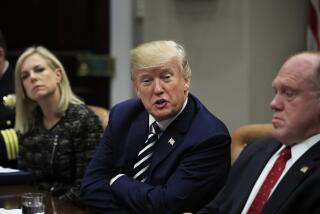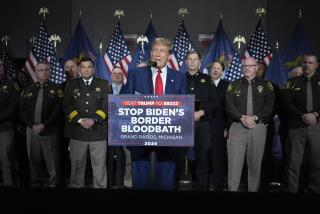Trump declares border emergency, testing the limits of presidential authority

The declaration comes after months of speculation and two years of failed negotiations over fortifying the southern border.
President Trump was brushed off by Mexico, outfoxed by Democrats and feeling abandoned by Republicans.
So on Friday, he declared the national immigration emergency he had been threatening for months, casting the fate of his signature campaign promise — a wall along the southern border — into the hands of a court system he acknowledged would be unpredictable.
It’s a risky strategy, one that drew strong rebukes from fellow Republicans. But Trump is betting that the potential payoff with his political base is worth the long-term risks to the institution of the presidency and the short-term divisions within his party.
Yet Trump, explaining that he “was a little new to the job” when he came to office in 2017, said he felt he had no choice now that his other efforts had failed over the last two years.
“We’re going to confront the national security crisis on our southern border,” Trump said in an event at the White House Rose Garden in which he delivered a long, rambling defense of his policies, touching on trade, drug control, the economy and the border.
“It’s all a big lie, a big con game,” he said of his opponents’ arguments against border barriers. “Walls work 100%,” he said.
Once he puts the emergency order into place, “we will then be sued … we will possibly get another bad ruling,” he said, reciting a litany of courts in a singsong voice. “We’ll end up in the Supreme Court,” where, he said, he hopes to “get a fair shake.”
The declaration is intended to circumvent Congress, which has refused to spend the billions needed to deliver a wall he had long insisted would be paid for by Mexico.
Administration officials say Trump will try to use emergency powers to divert money from other projects, mostly military construction efforts, to build or rebuild as much as 234 miles of border fences.
The emergency order would free an additional $6.6 billion for barrier construction, Mick Mulvaney, Trump’s acting chief of staff, told reporters.
That potentially would bring total spending on construction to $8 billion, including the $1.375 billion authorized by Congress in the spending bill, which passed Congress on Thursday and which Trump signed Friday afternoon.
Of the total, about $3.6 billion would come from the military construction projects. Most of the rest would come from an account for projects to combat drug trafficking.
With the expanded military budget that he’s pursued, the Pentagon can afford to divert some funds to the border, Trump said. “This is a very, very small amount” of the military budget, he added.
The administration decided not to try the more politically controversial step of tapping disaster relief money intended to help Texas and Puerto Rico, Mulvaney said. Officials also abandoned plans that had been considered earlier to try to take money away from California water projects.
Officials declined to specify which projects would lose money or suffer delays as a result of the decision to shift funds, though they insisted the military’s readiness would not be diminished.
Aides for key lawmakers also said they had yet to receive any information on which specific military construction projects would be targeted under the national emergency declaration.
Claude Chafin, a spokesman for the Republican minority on the House Armed Services Committee, said by their assessment about $21 billion in military construction funding — $11 billion from prior years and $10 billion from last year — had yet to be assigned to particular projects and could, in theory, be available for transfer.
Administration officials also declined to say where new barriers would be erected or rebuilt or how many new miles of barriers would actually be added to the fences that currently exist.
Building or repairing 234 miles was “our goal,” officials said, but made no promises.
“It’s going to be a little mix-and-match because instead of Congress just providing the money, the different pots have different authorizations for how and where we can use that money,” said a senior administration official who declined to be named under White House rules.
Trump has relaxed his demand for a solid structure that would cover the length of the border, yet still insists that hundreds of miles of steel bollard fencing are essential to the nation’s security.
So far, no additional miles of border fence have been built under his presidency — a contrast with each of his last three predecessors. Trump has tried to convince supporters that he’s making progress, in part by adopting a new slogan that implicitly takes credit for work previous presidents have done: “Finish the wall.”
Despite Republican control of both houses of Congress in his first two years in office, Trump was unable to strike a deal, in part because Democrats thwarted him, but also because fellow Republicans declined to make his wall their priority and he spurned deals that would have required him to accept compromises. Once Democrats took control of the House, his negotiating position worsened.
Congress could seek to overturn Trump’s emergency declaration, forcing him to use his veto power to defend his effort. The House likely will do so; in the Senate, such a measure would pass if four Republicans joined all the Democrats.
Already, several Republican senators have sharply criticized the declaration. Sen. Lamar Alexander, a Tennessee Republican, issued an unusually strong repudiation, calling the order unconstitutional.
“After the American Revolution against a king, our founders chose not to create a chief executive with the power to tax the people and spend their money any way he chooses,” Alexander said. “The Constitution gives that authority exclusively to a Congress elected by the people.”
Utah Sen. Mike Lee, another Republican, tweeted that although he believed Trump’s actions were legal, “Congress has been ceding far too much power to the exec. branch for decades. We should use this moment as an opportunity to start taking that power back.”
As Trump predicted, other opponents, including the American Civil Liberties Union, have already said they would challenge him in court. Trump may have given ammunition to critics who say the emergency is manufactured by saying Friday that his declaration is a matter of preference rather than urgency.
“I could do the wall over a longer period of time,” Trump said. “I didn’t need to do this, but I’d rather do it much faster.”
In addition to a likely court fight over whether his emergency declaration is a valid use of presidential power, aggressive building plans could open Trump to confrontations with landowners along the border who have argued that building a barrier through their property violates their rights.
Fences already line nearly all the border from the Pacific Ocean through California, Arizona and New Mexico — just short of 700 miles, mostly through publicly owned land. But the more than 1,000 miles of borderland in Texas mostly lies in private hands and is mostly unfenced.
Trump, who is eager to show supporters he is keeping his promises, could opt to spend less money and build fewer miles if he believes his supporters will give him credit for the sheer act of boldness in declaring an emergency.
Even that support is far from a slam dunk, however.
Ann Coulter, the conservative commentator, called the declaration a “ruse” that “was always just a way to fool the rubes in his base” in a Thursday night tweet and speculated Friday that Trump could be constitutionally removed from office. She faulted Trump for accepting the spending bill.
Fox host Sean Hannity, another conservative media advisor, has been encouraging the national emergency move, writing on Thursday that “Trump keeps his promises. I predict he’ll find a way to get the money to build the wall.”
Trump made clear Friday that he saw support from such media allies as critical yet also fragile.
“Sean Hannity has been a terrific, terrific supporter of what I do,” he said. “Not of me. If I changed my views, he wouldn’t be with me.”
The decision epitomizes Trump’s tenure in the White House. While other presidents have wielded emergency authority, they have generally done so to sanction foreign adversaries or combat domestic crises, such as epidemics. Trump is pushing beyond what others have tried in pursuing an emergency declaration to fund projects that were explicitly rejected by Congress, which has the constitutional power of the purse.
Administration officials said Friday that presidents have used national emergency powers 58 times since 1976. Only two of those instances involved spending money, they said, pointing to orders signed by George H.W. Bush during the Iraq war in 1990 and by George W. Bush following the 2001 terrorist attacks. Officials said the authority was used in those instances to spend a combined $1.4 billion not authorized by Congress.
Some Republicans have cautioned Trump against seeking to use emergency powers to spend additional money, fearing future Democratic presidents would seek to declare emergencies to battle climate change, enact gun control measures or tackle other ideologically polarizing initiatives.
Mulvaney sought to rebut that argument.
Trump’s move “actually creates zero precedent,” he said. “This is authority given to the president under law already.”
Trump was among the vocal group of Republicans who accused President Obama of overstepping his authority when he issued executive actions to preserve public lands and protect millions of immigrants from deportations.
Polls show overwhelming opposition to Trump’s decision. Yet Trump sees keeping his core supporters placated as essential to his reelection prospects.
“Only one-third of the public supports using an emergency declaration to build a border wall. The question is whether Trump has plans to explain this decision to try to broaden that support or if this is simply a move to satisfy his base,” said Patrick Murray, director of the nonpartisan Monmouth Poll.
Monmouth released a survey in late January showing just 34% of Americans favor using an emergency declaration that would allow the use of military funds for the wall.
Times staff writer Molly O’Toole in Washington contributed to this report.
Follow the latest news of the Trump administration on Essential Washington »
More to Read
Get the L.A. Times Politics newsletter
Deeply reported insights into legislation, politics and policy from Sacramento, Washington and beyond. In your inbox three times per week.
You may occasionally receive promotional content from the Los Angeles Times.







